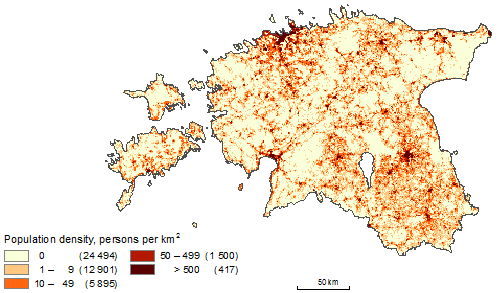Based on the 2011 census, the most densely populated area in Estonia is the Lasnamäe city district
Almost 25,000 square kilometres (55%) of the total area of Estonia are uninhabited. A tenth of the Estonian territory is sparsely populated, with only 1–2 inhabitants per square kilometre. With 15,800 inhabitants per square kilometre, the Linnamäe-Kärberi streets area in Lasnamäe city district has the highest population density. There are more than 15,000 inhabitants per square kilometre also in the Laagna sub-district and Mustamäe city district (Vilde-Mustamäe tee streets area). The average population density in Estonia is 30 inhabitants per square kilometre. In the previous census in 2000, the population density was 32 inhabitants per square kilometre. The average population density in EU countries is 117 inhabitants per square kilometre. Malta is the most densely populated EU country with 1,316 inhabitants per square kilometre. Compared to Estonia, only Scandinavian countries and Iceland have lower population density. In Latvia and Lithuania the average population density is 36 and 52 inhabitants per square kilometre, respectively.
The grid map based on the 2011 census visualizes the residential distribution of the Estonian population. Larger cities and their hinterlands can clearly be distinguished on the grid map. This distributional pattern is influenced by natural conditions – large wetlands and woodlands are uninhabited, and population density is greater near the roads.
A grid map is a map where statistical data are presented in uniform territorial units, i.e. grids. The grid map is based on geo-referenced statistical data collected during the census. These data enable a more detailed spatial analysis and comparison of population distribution over time and space, irrespective of changes in administrative boundaries. Grid maps are mainly used for thematic planning and preparation of development plans.
Based on the 2011 Population and Housing Census, 1 km x 1 km grid data are available for the territory of Estonia, 500 m x 500 m grid data for cities and their hinterlands, and 100 m x 100 m grid data for the cities of Tallinn, Tartu, Pärnu, Narva and Kohtla-Järve.
Population density of Estonia, Population and Housing Census 31.12.2011

A higher-resolution map can be seen here.